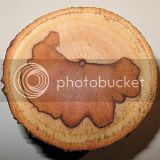Roy_H
Established Member
Today, the 100+yr-old beech tree in out garden was felled at last. It was massive, but sadly under attack from a lot of fungus and rot.
On the bright side, here's a sample from a smallish (120mm) branch:

There is a lot more like this, up to 500+ mm diameter...
So, I'm okay with waxing and sealing freshly sawn logs of quite small proportions, but what should I do with a whole tree?!
I'm keen to try out my Woodcut hollower on some of this wet timber to rough down some shapes for drying, but once they've been wet turned what's the best way to dry them out? Should I seal them in any particular way?
Also, what's a good diameter to start with on my Coronet 3 lathe? - I'm rather spoilt for choice when it comes to timber size, but am conscious that the lathe will only be able to take so much.:-k
I'm new to this aspect of turning - as green as the timber in fact... :roll:
Any advice would be greatly appreciated - and if anyone near East Herts has a mobile sawmill and fancies some beech, let me know
On the bright side, here's a sample from a smallish (120mm) branch:

There is a lot more like this, up to 500+ mm diameter...
So, I'm okay with waxing and sealing freshly sawn logs of quite small proportions, but what should I do with a whole tree?!
I'm keen to try out my Woodcut hollower on some of this wet timber to rough down some shapes for drying, but once they've been wet turned what's the best way to dry them out? Should I seal them in any particular way?
Also, what's a good diameter to start with on my Coronet 3 lathe? - I'm rather spoilt for choice when it comes to timber size, but am conscious that the lathe will only be able to take so much.:-k
I'm new to this aspect of turning - as green as the timber in fact... :roll:
Any advice would be greatly appreciated - and if anyone near East Herts has a mobile sawmill and fancies some beech, let me know




